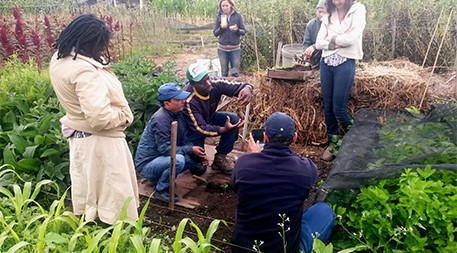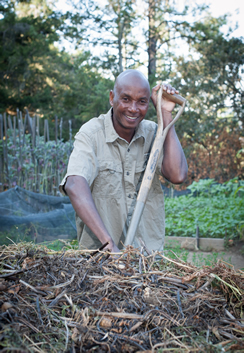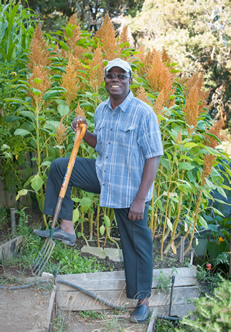How Three US Mini-Farms Are Sowing the Seeds of Global Food Security (continued from Page 1 )
Sammy Kangethe, a Kenyan who is planting potatoes alongside Benedict at the Golden Rule Mini-Farm, is also a serious student of agriculture. Less ebullient but just as driven, he taught HIV patients in Nairobi slums to grow food on small communal plots of donated land before starting this internship. "I saw that the HIV drugs didn't work if patients didn't also eat healthy food, so I came here to learn more about growing it in a small space," he says. Kangethe's experiments involve amaranth, artichokes and beets. "The goal is to empower people to grow enough food with less land and water so they can feed themselves and their families and even sell some in the city for income," he says. The Jeavons Center Mini-Farm
"If you give the soil what it needs—the nutrients in compost—it gives you what you need to eat," Mlegwah says. "If the soil is healthy and strong, the plant is healthy and strong, and the people are healthy and strong who eat the plant. Too many chemicals are used in Kenya, which suffocate and poison the soils, causing a chain reaction that leads to polluted soil, water and air." Mlegwah notes that key to Biointensive's success is to provide the right water, soil, organic-matter, biological and mineral conditions for plants to thrive. Through Garden of Hope, a nonprofit he founded in Kenya, he aims to teach this approach to children beginning at age 5. "We will start by teaching them the value of preserving the environment and sustainable growing," he says, "and to analyze what they eat." Fellow intern Jean Apedoh is from Togo, where he was raised on a rice farm. For his experiment, he is growing rice with minimal water. "Rice doesn't need that much water, or any chemicals, to grow well," Apedoh says. Through a nonprofit he founded in Togo, the agricultural engineer trained 2,000 farmers in 2015 before coming to Mendocino County to enhance his knowledge of sustainable practices. Like the soil at the farms, Jeavons' spirit is constantly renewed by the interns who have come and gone, scattering the seeds of Biointensive knowledge to small-scale farmers around the globe. He learned Biointensive methods from British horticulturist Alan Chadwick—and notes that they were used for centuries in China, Japan, Korea, Greece, Guatemala, the Philippines and Iran. His mission is to bring them back to the world, which he's done through 44 years of garden research, sharing the results through publications and online materials, establishing the intern program, writing a book and leading multi-day GROW BIOINTENSIVE mini-farm workshops that have been completed by more than 2,000 people. Another Way "We're like a family, so it's sad each year when the interns leave," says Golden Rule Field Coordinator Rachel Britten. Gazing over the crowded crop rows that emit the fragrance of new grains, vegetables and seeds, Britten notes that much thought goes into what's planted. "'Carbon-and-calorie' plants such as corn, sorghum and barley—which offer high yields, calorie density and lots of stored carbon from which to make compost for soil replenishment—are a critical part of the system," she says. So is balance, with a goal of 60 percent carbon-and-calorie plants, 30 percent root crops (such as potatoes, parsnips and leeks) and 10 percent traditional vegetables and fruits for dietary variety, vitamins and minerals. All edible and biomass yields are measured, and soil tests ensure closed-loop soil fertility. Global Impacts
Ecology Action is increasingly using the internet to spread information, with numerous free and low-cost videos, webinars and instructional materials in multiple languages at its website and educational portal, plus a growing presence on social media. But the heart of its efforts to plant the seeds of sustainable farming on every continent is still found at the mini-farms in the big-hearted zeal of the interns. "With Biointensive, we could sustainably produce food for everyone on Earth and still leave half of the farmable soil untouched," says Jeavons. It's a big goal, but devotees of these farming methods believe that if they can convince enough people that it's practical and essential, they can achieve it, one plant at a time.
Go to: Page 1 | Page 2
top | Newsletter Home |Table of Contents| Archive
|



 farms in the county (backyard gardeners and schoolchildren are taught at a fourth farm in Palo Alto).
farms in the county (backyard gardeners and schoolchildren are taught at a fourth farm in Palo Alto).

 Bob Cooper is a San Francisco-based freelance writer with recent stories in National Geographic Traveler and Hemispheres. He covers travel, outdoor sports and many other topics, but the stories he most enjoys writing are profiles of people who are making a positive difference in the world.
Bob Cooper is a San Francisco-based freelance writer with recent stories in National Geographic Traveler and Hemispheres. He covers travel, outdoor sports and many other topics, but the stories he most enjoys writing are profiles of people who are making a positive difference in the world.
